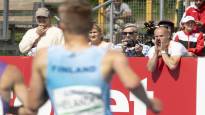Finland even takes a record jackpot from its great home games. How are these junior medals of really grown people refined into adult success? asks Pekka Holopainen.
Pekka Holopainen Sports journalist
At the Under-23 European Championship in Leppävaara, Espoo, despite Finland’s amazing flying weather, the Athlete of the Year is not announced. But the most exciting sports moment of the year has been chosen. A man’s heart is a stone if a 5000 meter silver runner by Eemil Helander coach, terminally ill with cancer Ari Nummelan crying scene Urheilun by Laura Arffman was not deeply moved in the interview.
When this athletics competition format was launched in Turku in 1997, the Finnish team’s haul of nine medals at that time has been considered forever unbroken in its sport.
Now it is about to be broken, because in addition to the sure nails, some of the Finns who were predicted to be below the medal level have managed to absorb all the positives from the home field advantage.
Fireworks
Friday night was an amazing Finnish track and field fireworks display Saga Vannisen and Silja Kosonen under.
The scale is wide, as the host country now has medals in jumping, throwing, matches, middle distance running, endurance running and walking. Finland ended the last day of the competition in third place, third in the medal tally.
Last August in Munich, Finland broke a seven-year streak without a medal in the adult championships with no less than four strokes.
The big peculiarity of the event was that no new medalists lived Kristiina Mäkelä, Top Raitanen, Lassi Etelätalo or even unexpectedly Wilma Murto had not achieved a European Under-23 medal.
The first Finnish medalists in both adults and under 23 year olds were Janne Holmen and Heli Koivula 2002. Over the course of 21 years, exactly a dozen different Finns have received an adult competition medal, and no less than seven of them are also medalists under the age of 23.
So there is a lot of predictive value, but on the other hand, in the past 20 years, there have been dozens of adult elite athletes without a single Finnish medal. U23 success has not been correlated there, and without one Tero Pitkämäki this record would look even more gruesome.
Not too many good athletics competitions are organized in Finland either, and Espoo’s winners have deserved their celebration.
A perpetual problem
At the same time, in Leppävaara, the eternal problem of top Finnish sports coaching culminates, i.e. saying goodbye to the youth phase and a decisive, quick transition to adult success at the international level. It is often an impossible place for the Finnish system. Let’s make the bottoms of the carts a little long enough that the trailer that is moving away from the adult train can no longer be seen.
Even though the competitions are great, some of the top sports junkies of the hardest hardcore section remind us that junior medals are de facto handed out to adult people in Espoo. It is undoubtedly a fundamental paradox. The U23 format competes for athletics continental medals only in Europe.
Last year, at the World Championships in Eugene, a dozen athletes achieved a medal at an age that would have allowed them to compete at the U23 level. One of them was Jakob Ingebrigtsen, Armand Duplantis was already a year too old. Both of them skipped the U23 competitions completely. There was no need or attraction for them.
Karsten Warholm again continued to the U23 championship summer from the youth events directly to the men’s WC gold.
Of course, we are talking about perfect exceptional individuals, but the idea becomes clear.
In Finland, something surprises us Iivo from Niska, who “already” achieved Olympic gold at the age of 22. That is, in the prime of an international top athlete.
